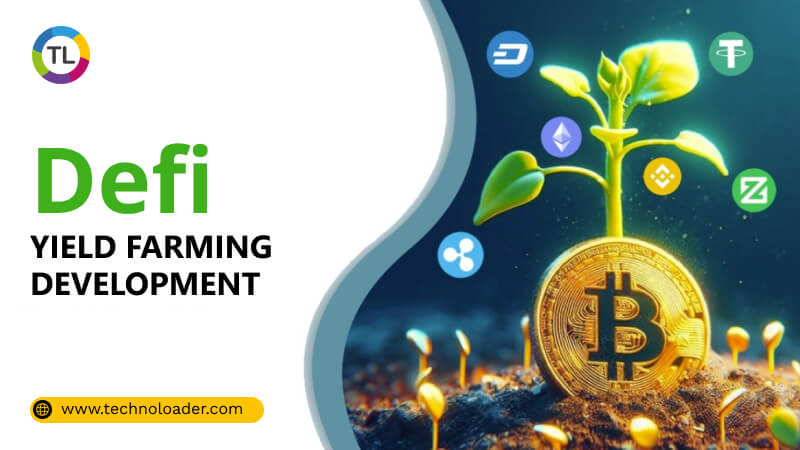Have you ever wondered how you can make your cryptocurrency work harder for you? Talk about DeFi yield farming! This innovative approach allows you to earn passive income on your crypto assets by participating in decentralized finance protocols.
Think of yield farming as a way to plant your digital seeds and watch them grow, with the potential for impressive returns. Sounds intriguing, right?
In this complete guide, we’ll break down everything you need to know about DeFi yield farming development—its strategies, benefits, and the key players in the field.
So, without further ado, let’s get started!
Table of Contents
- 1 What is DeFi Yield Farming?
- 2 How does DeFi Yield Farming work?
- 3 DeFi Yield Farming vs Traditional Investment Methods: Similarity and Difference
- 4 How to Get Started with Yield Farming
- 5 What are the DeFi Yield Farming platforms and protocols?
- 6 Challenges and Risks in Yield Farming
- 7 The Future of DeFi Yield Farming
- 8 Hiring the Best DeFi Yield Farming Development Company
What is DeFi Yield Farming?
DeFi Yield Farming is a way to earn passive income by providing liquidity to decentralized finance (DeFi) protocols. In simple terms, it involves depositing your cryptocurrency into a liquidity pool, where it’s used by others to borrow, trade, or earn rewards. In return, you receive interest, incentives, or even additional cryptocurrency. This process is known as “yield farming” because just like farming crops, your assets “grow” over time by generating rewards.
The core of DeFi yield farming is liquidity. Liquidity pools allow decentralized exchanges and platforms to operate smoothly by ensuring there’s always enough assets available for trading. Liquidity providers, the users who deposit their funds into these pools, are rewarded with a portion of the fees generated by the platform. They also receive tokens representing their share in the pool, which can sometimes be traded or staked for even more profit.
Yield farming isn’t just beneficial for liquidity providers. Borrowers also gain access to quick liquidity for trading or other financial activities. This ecosystem is managed by smart contracts, which automatically execute the agreements between participants without the need for a centralized authority.
In short, DeFi yield farming offers a unique way to maximize your crypto assets, providing both flexibility and profit potential in the DeFi space.
How does DeFi Yield Farming work?
At its core, yield farming allows users to provide liquidity by depositing their cryptocurrency into liquidity pools, which are essentially smart contracts. These smart contracts facilitate various financial transactions, including token swaps, lending, and borrowing, creating a dynamic marketplace.
Here’s how it works in detail:
Step 1: Depositing Funds
As a liquidity provider, you begin by depositing funds into a liquidity pool. These pools often consist of stable coins like DAI, USDT, or USDC, which are pegged to the USD. By locking your assets in these smart contracts, you help maintain liquidity in the DeFi platform while also protecting your investment.
Step 2: Engaging in a Marketplace
Once your funds are deposited, they become part of a larger marketplace where users can exchange, borrow, and lend cryptocurrencies. The DeFi users pay fees for these transactions, which directly benefit liquidity providers.
Step 3: Earning Returns
For locking up their funds, liquidity providers earn returns based on the fees generated from the platform’s transactions. The amount of return you receive correlates with the value of your investment and the specific protocol of the platform.
Step 4: Reinvesting for Greater Rewards
The rewards you receive—often in the form of tokens—can be reinvested into other liquidity pools, enabling you to diversify your crypto asset portfolio. This strategy not only maximizes your potential returns but also enhances your overall yield farming experience.
DeFi Yield Farming vs Traditional Investment Methods: Similarity and Difference
DeFi yield farming shares some similarities with traditional investment methods, but it also introduces key differences that make it unique. Just like in traditional finance, where you can earn interest through savings accounts, certificates of deposit (CDs), or dividend-paying stocks, yield farming allows you to generate returns on your assets. However, the crucial distinction lies in the operational framework.
In traditional finance, these investment options rely on intermediaries, such as banks or brokers, to facilitate transactions. Conversely, yield farming operates in a decentralized environment, where lending and borrowing occur directly between users without intermediaries. This peer-to-peer (P2P) model is executed through smart contracts, which automatically manage transactions based on predefined conditions.
This shift from a centralized to a decentralized system not only enhances efficiency but also empowers users with greater control over their investments, making yield farming a revolutionary alternative to traditional finance.
How to Get Started with Yield Farming
Here’s how you can get started with Defi Yield Farming Development –
Setting Up a Cryptocurrency Wallet
To embark on your yield farming journey, the first step is setting up a cryptocurrency wallet. Options like MetaMask, Trust Wallet, or Coinbase Wallet are user-friendly and secure. These wallets will allow you to store your digital assets and interact with various DeFi platforms seamlessly.
Choosing the Right DeFi Platform
Next, you’ll need to choose a DeFi platform that suits your needs. Popular platforms like Aave, Compound, and Uniswap offer unique features and yield opportunities. Research each platform’s offerings, fees, and community reputation to make an informed choice.
Understanding the Risks Involved
Yield farming carries inherent risks, including smart contract vulnerabilities and market volatility. It’s essential to familiarize yourself with these risks before committing your funds, as they can impact your investment.
Once you’re set up, follow these steps:
- Select a Strategy: Decide whether you want to lend, stake, or engage in liquidity mining based on your risk appetite.
- Providing Liquidity: Deposit your assets into a liquidity pool or platform, allowing you to earn rewards like interest or tokens.
With these steps, you’re ready to dive into the world of yield farming and start maximizing your crypto assets!
What are the DeFi Yield Farming platforms and protocols?
There are various yield farming platforms and protocols that offer unique opportunities for investors. Each comes with its own set of rules, features, and risks. Here are some notable DeFi yield farming platforms:
Compound Finance
As one of the most recognized protocols, Compound Finance allows users to lend and borrow cryptocurrency assets. Users can contribute assets from their Ethereum wallets to a liquidity pool, earning rewards based on their contributions.
Yearn Finance
Yearn Finance is a decentralized platform that converts assets into liquidity tokens, which are given in exchange for deposits. This platform is particularly beneficial for periodic rebalancing, helping users optimize their investment strategies.
Uniswap
A leading decentralized exchange (DEX), Uniswap facilitates seamless token swapping. Liquidity providers deposit equal-value tokens into the pool, earning fees from trades, making it a favored choice among yield farmers.
Aave
Aave operates as an open-source, non-custodial lending network where interest rates adjust automatically based on market conditions. Lenders receive tokens in exchange for their deposits, which are crucial for generating quick returns and compounding interest. Aave also offers innovative features like flash loans.
Balancer
This multi-token automated market-making platform allows users to create and manage liquidity pools with flexible token allocations. Balancer offers attractive trading fees, enabling users to optimize their yield farming strategies.
Curve Finance
Curve Finance is designed for high-value exchanges using stablecoins with minimal slippage. Supporting various stablecoin pairings like USDC, DAI, and TUSD, it allows users to trade quickly and efficiently.
MakerDAO
A pioneer in DeFi, MakerDAO enables users to create the stablecoin DAI by locking up collateral like USDC or ETH in a Maker vault. Users accrue interest on their loans, determined by MKR token holders.
Synthetix
Synthetix is a synthetic protocol that allows users to mint synthetic assets that mirror real-world assets, providing reliable price feeds for various commodities, cryptocurrencies, and fiat currencies.
These platforms exemplify the diverse strategies available in DeFi yield farming, catering to various risk appetites and investment goals. As you explore these options, it’s crucial to understand the specific mechanisms and potential risks associated with each platform.
Challenges and Risks in Yield Farming
Yield farming offers enticing rewards, but it’s essential to recognize the challenges and risks involved.
Smart Contract Vulnerabilities
One of the primary risks in yield farming is the potential for smart contract vulnerabilities. Since DeFi platforms rely on complex code, flaws or bugs can lead to significant financial losses. Hackers can exploit these vulnerabilities, resulting in stolen funds or frozen assets.
Market Volatility
Cryptocurrency markets are known for their volatility. Prices can fluctuate dramatically within short periods, impacting the value of the tokens you are farming. This volatility can lead to unexpected losses, especially if you need to liquidate your positions during a downturn.
Impermanent Loss
Another challenge is impermanent loss, which occurs when the price of tokens in a liquidity pool diverges significantly. If you provide liquidity to a pool and the token prices change unfavorably, you could end up with fewer funds than if you simply held the tokens in your wallet.
Regulatory Concerns
Finally, regulatory uncertainties pose a risk for yield farmers. As governments worldwide develop regulations around DeFi and cryptocurrency, new rules could impact how these platforms operate, potentially affecting your investment strategy. Being aware of these challenges is crucial for navigating the yield farming landscape effectively.
The Future of DeFi Yield Farming
As of 2024, the total value locked (TVL) in DeFi surpassed $190 billion, marking a remarkable growth trajectory from previous years. This surge indicates a strong interest in yield farming and decentralized finance.
Emerging trends suggest a shift towards more user-friendly interfaces, making yield farming accessible to a broader audience. Additionally, innovations such as cross-chain compatibility and advanced algorithmic stablecoins are likely to enhance liquidity and efficiency.
With these developments, the DeFi landscape is set to evolve, offering more opportunities and improved risk management for yield farmers, ultimately shaping a more robust financial ecosystem.
Hiring the Best DeFi Yield Farming Development Company
In conclusion, selecting the right DeFi yield farming development company is crucial for navigating this rapidly evolving landscape. With the potential for high returns and innovative opportunities, partnering with an experienced team can help you capitalize on the benefits while minimizing risks.
Technoloader stands out as one of India’s leading development companies, offering expert solutions tailored to your specific needs. Whether you’re looking to launch a new platform or enhance an existing one, Technoloader has the expertise to drive your project to success.
Contact us today to explore how we can assist you in your DeFi journey!
Quick Contact Us : 📞
Call/whatsapp : 👉 +91 7014607737
Telegram : 👉 @vipinshar
Email : 👉 [email protected]









